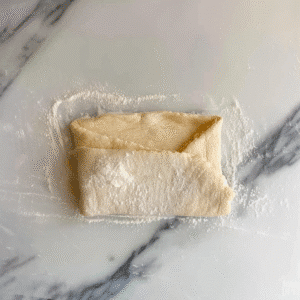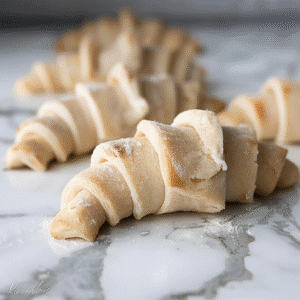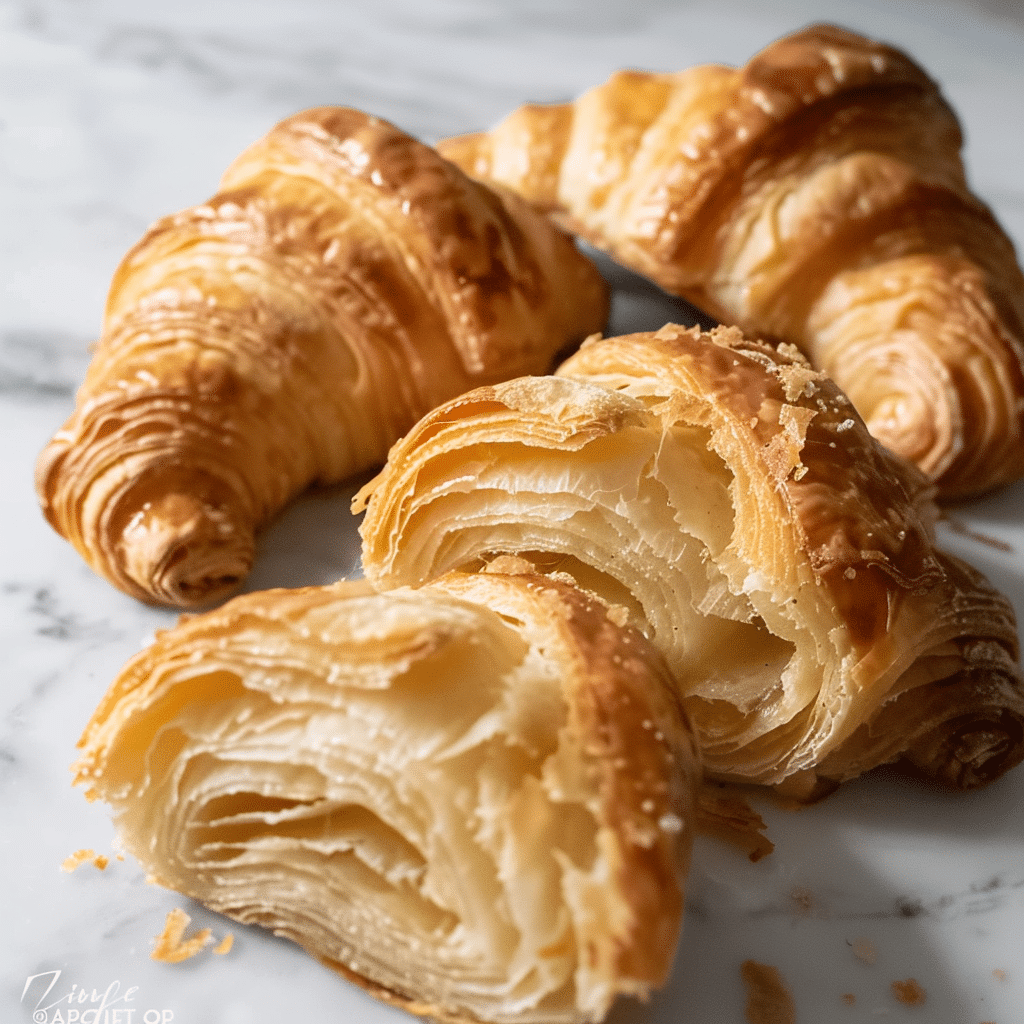Gluten Free Croissant Recipe lovers, you’re in for a treat. This guide walks you through exactly how to create that buttery flaky texture with homemade gluten free croissant dough that’s rich, soft, and perfectly layered. Inspired by my roots and pop-up kitchen experiments, I’ve developed a method that’s both doable and deeply satisfying.
Whether you’re new to gluten free pastry dough or sharpening your lamination skills, you’ll find real chef-tested advice grounded in Soulful Flavors, Honest Cooking. Let’s bake something unforgettable.
Can I make croissants with gluten free puff pastry?
Yes, you can make croissants with gluten free puff pastry, but the texture will differ from traditional croissants. Puff pastry lacks yeast, so it won’t rise the same way. You’ll still get flaky layers, but not the soft, airy crumb. For genuine results, use laminated gluten-free dough with yeast.
📄 Want to keep this recipe for later? Download your printable PDF version now and start cooking anytime!
📥 Download Recipe PDF✅ Print-friendly • 🕒 Save for later • 📱 Mobile-accessible
💡 Want more like this? Subscribe for weekly printable recipes!
Table of Contents
Table of Contents
- Can I make croissants with gluten free puff pastry?
- From Bronx Mornings to Gluten Free Mastery
- Getting That Buttery Flaky Texture with Smart Techniques
- Why Lamination Still Matters in a Gluten Free Croissant
- Tips for Handling Butter and Preventing Breaks
- How to Shape Gluten-Free Croissant Like a Pro
- Proofing Letting the Layers Rise with Patience
- What Happens in the Oven is Everything
- How to Know When It’s Fully Baked
- How to Store Gluten Free Croissants Without Losing Texture
- Creative Serving Ideas and Pairings
- Common Mistakes and How to Avoid Them
- Recovering from a Mishap Mid-Recipe
- Built on Real Kitchen Experience Not Just Theory
- Repeatable Results for Every Home Baker
- Frequently Asked Questions About Gluten Free Croissants
- Can I make croissants with gluten free puff pastry?
- Are any pastries gluten free?
- Does France have gluten free croissants?
- Is there a gluten free pastry?
Why Gluten Free Croissant Deserve Their Own Spotlight
From Bronx Mornings to Gluten Free Mastery
I didn’t grow up eating croissants in Paris I grew up in a Bronx kitchen where flavor mattered more than formality. After my first croissant I was instantly hooked. As a chef today my mission is inclusive accessible comfort food. Creating a homemade gluten free croissant became a personal challenge. I wasn’t just imitating the original I wanted to capture that buttery flake and soul in a way that felt real for those who can’t eat gluten.
Getting That Buttery Flaky Texture with Smart Techniques
Croissants are known for their layers but achieving that in gluten free pastry dough means rethinking structure. Wheat flour provides natural elasticity but gluten free alternatives require balance. That’s where Cup4Cup gluten free flour shines high in starch ideal for lamination without losing texture. Temperature control is key. Chilling between folds keeps butter firm creating a golden lift when baked.
The result? A tender crisp croissant full of character. It’s about more than gluten free it’s honoring the process and making something extraordinary.
This recipe is central to my pop-up prep and virtual classes helping home cooks bake confidently. If you love croissants check out my lemon blueberry delight layered in flavor too.
Around here every fold and egg wash carries the spirit I learned from my abuela Soulful Flavors Honest Cooking.
Print
Gluten Free Croissant – Aaron Recipes
- Total Time: 4 hours 35 minutes
- Yield: 10 croissants 1x
- Diet: Gluten Free
Description
These gluten free croissants are rich, flaky, and filled with buttery gluten free layers that rival any traditional French pastry. With a crisp golden crust and soft, pull-apart inside, they’re perfect for breakfast or brunch when you want bakery-quality results at home.
Ingredients
**For the Dough**
2 ¼ cups (315 g) gluten free pastry flour or Cup4Cup, plus extra for rolling
2 teaspoons (6 g) instant yeast
2 tablespoons (24 g) granulated sugar
1 teaspoon (6 g) kosher salt
3 tablespoons (42 g) unsalted butter, melted and cooled
¾ cup (6 fl oz) whole milk, room temperature
**For the Butter Packet**
16 tablespoons (224 g) unsalted butter, chilled
¼ cup (36 g) gluten free pastry flour or Cup4Cup
1 egg + 1 tbsp water, beaten well (for egg wash)
Instructions
1. In a large bowl, whisk flour, yeast, and sugar. Add salt, then mix in butter and milk until dough forms.
2. Lightly flour surface and roll dough into a 9-inch round. Wrap and chill.
3. Prepare butter packet by pounding chilled butter and flour between parchment into a 5-inch square. Chill again.
4. Place butter packet in center of chilled dough. Score corners, roll flaps, and wrap butter like a present.

5. Roll out into ½-inch thick rectangle. Fold like a letter. Repeat 4–5 turns, chilling between each.

6. Roll out finished dough to ¼-inch thick. Cut into 4×6-inch rectangles, then diagonally into triangles.
7. Roll triangles from base to tip. Place seam-down on baking sheet, 2 inches apart.

8. Proof croissants until doubled in size. Brush tops gently with egg wash, brushing outward from center.
9. Chill proofed croissants for 10 minutes. Preheat oven to 400°F.
10. Bake for 20 minutes or until deep golden brown and firm. Cool slightly before serving.
Notes
To make your own gluten free pastry flour, combine 80% all-purpose GF flour (with xanthan gum), 10% cornstarch, and 10% milk powder by weight.
Always chill between folds to maintain clean layers.
Reheat leftover croissants in the oven at 325°F for 6–8 minutes, never microwave.
- Prep Time: 45 minutes
- Cook Time: 20 minutes
- Category: Dessert
- Method: Baking
- Cuisine: French
Nutrition
- Serving Size: 1 croissant
- Calories: 310
- Sugar: 3g
- Sodium: 190mg
- Fat: 20g
- Saturated Fat: 13g
- Unsaturated Fat: 6g
- Trans Fat: 0g
- Carbohydrates: 28g
- Fiber: 1g
- Protein: 4g
- Cholesterol: 55mg
Laminating the Dough for Gluten Free Croissant
Why Lamination Still Matters in a Gluten Free Croissant
Laminating dough is truly where the magic starts. If you’ve ever wondered how croissants get their signature flake, it’s all about layering cold butter between sheets of dough. Even gluten free croissant dough relies on lamination to deliver that flaky lift, as long as you handle it with care and keep your rolling pin cold.
Without gluten, the structure depends on starch, fat, and chill time. This process isn’t quick but it’s definitely rewarding. In my pop-up classes, I always remind bakers to trust the process. Done right, your gluten free croissants will puff, brown, and practically sing when you break them open.
Tips for Handling Butter and Preventing Breaks
The butter must be cold yet pliable. Too firm and it cracks the dough; too soft and it melts, losing those distinct layers. I use just enough flour to keep things smooth, never sticky, and always chill the dough between folds. After every turn, the dough heads back to the fridge on schedule.

Each fold builds beautiful definition. After four or five folds, your gluten free croissant dough looks like a promise, ready to shape. I’ve had great success laminating a gfJules flour blend, especially when teaching gluten free baking tips in pastry classes.
For a rich twist, try this creamy strawberry tiramisu recipe. It’s a reminder that every bite should feel earned and satisfying. This dough is more than just flour and butter, It’s the foundation of flavor, texture, and joy. When you bite into a finished gluten free croissant, all that folding and chilling is absolutely worth it.
Shaping and Proofing for Perfect Gluten Free Croissant
How to Shape Gluten-Free Croissant Like a Pro
Shaping gluten-free croissant takes a bit of care but is totally doable. I begin by slicing neat, sharp triangles without rough edges. Gently stretch, notch the base, and roll them up with purpose. The dough is softer than wheat dough so treat it like soft clay.
For a better rise, roll from the base to the tip, guiding layers inward but avoid pressing them down. Many students master this with practice and patience in virtual classes. When shaped and placed on a tray, leave enough space between croissants to allow them to expand, That’s key for a light airy crumb.
Proofing Letting the Layers Rise with Patience
Proofing is a crucial step giving your croissants structure before baking. Cover loosely and keep the temperature steady, Not too hot, just warm enough to activate yeast. After a few hours you’ll see a visible lift between coils. That’s your sign the gluten free croissants are ready.
Lightly brush with egg wash along the grain. This preserves the laminated layers and lets the glaze shine without sealing the dough. The buttery aroma starts to fill the kitchen, Every batch reminds me of pop-up mornings. That smell means joy is just minutes away.
I enjoy serving these croissants alongside my limoncello tiramisu recipe for a bright lemon finish on your brunch table. This proofing step turns folded dough into golden pastry art. When done carefully, you won’t miss gluten one bit.
Baking the Perfect Gluten Free Croissant
What Happens in the Oven is Everything
After all the folding, shaping, and proofing, the real magic happens in the oven. This is where your gluten free croissant develops its flaky golden crust. High heat around 400°F is key. It gives the butter the lift it needs to form layers without causing the dough to collapse.
I always chill the shaped croissants before baking. Cold dough hitting a hot oven creates maximum lift. You’ll see the sides puff and layers gently separate like delicate pastry armor.
The aroma fills the kitchen and instantly transports me to a Parisian bakery on an early morning.
How to Know When It’s Fully Baked
A perfectly baked gluten free croissant will be a deep golden brown and crisp when touched. Avoid underbaking those rich layers need time to set inside. I turn the trays midway through baking to ensure even browning. Tapping the tops should give a hollow flaky sound.
Inside you’ll find a honeycomb crumb that’s never gummy or dense. Stick to the method and that laminated texture will shine through.
Pair these with creamy delights like my banana pudding with cheesecake pudding for a comforting contrast.
Whether for brunch or a special weekday treat, the gluten free croissant deserves this moment of oven glory where all your hard work shines.
Storing and Serving Gluten Free Croissants
How to Store Gluten Free Croissants Without Losing Texture
Once your gluten free croissants are baked, you can enjoy them fresh or save them for later. Allow them to cool fully on a wire rack before storing.
For short-term storage, wrap in foil or place in airtight containers and refrigerate for 2 to 3 days. Reheat in a 325°F oven for 6 to 8 minutes never use a microwave as it ruins the flake.
To freeze wrap each croissant individually in parchment paper and foil. Reheat from frozen without thawing to keep the crust crisp and inside tender.
Creative Serving Ideas and Pairings
Gluten free croissants are delicious on their own but can be dressed up. Slice open and fill with whipped ricotta and fresh berries or try melted brie with herbs for a savory twist.
I love pairing them with lemon curd or adding them to a gluten free French pastry brunch board with mini tiramisus and spiced jams.
For a delicate treat, try the matcha tiramisu it balances bitter and sweet beautifully.
The gluten free croissant transforms your table whether served simply with coffee or as an elegant centerpiece bringing people together like every dish I cherish.
Troubleshooting Your Gluten Free Croissant
Common Mistakes and How to Avoid Them
Even the best gluten free croissant recipe can go wrong if you rush or skip key steps. A common issue is butter melting during lamination caused by rolling dough that is too warm. Always chill the dough between folds. If it resists or the butter softens, refrigerate it, Patience protects your flaky layers.
Another problem is dough tearing or sticking, often due to too much moisture or not enough flour. Measure carefully and use flour sparingly to keep the dough easy to handle.
Skipping chill times, undermixing, or underproofing can cause a flat rise. Check your yeast freshness and proofing environment if the croissant is dense.
Recovering from a Mishap Mid-Recipe
If the butter breaks through or the dough sticks, don’t worry. Wrap it tight and chill for 30 minutes to make it easier to work with. Many home bakers have rescued their pastry this way during live classes.
If your first batch flops, consider it a practice round. My first gluten free croissants looked more like pancakes but improved dramatically with each try.
For a no-stress dessert break, try this pistachio lemon bar with its sweet nutty balance.
Why This Gluten Free Croissant Recipe Works Every Time
Built on Real Kitchen Experience Not Just Theory
This recipe was developed in a busy Brooklyn kitchen, through trial and observation rather than formal training. I learned to read dough texture, listen to butter in the oven, and recognize perfect folds by feel.
That’s why it works, It’s designed for real home bakers, with no need for fancy tools or perfect timing. Just patience and willingness to try.
Remember, a great gluten free croissant is about care and intention, not perfection.
Repeatable Results for Every Home Baker
This method teaches why each step matters, Letting butter rest, folding for structure. Understanding this makes every croissant easier and more rewarding.

Beginners often create bakery-quality pastries on their first try with this approach. It’s about bringing flavor and texture back without gluten.
For another show-stopping treat, try my Dubai chocolate tiramisu, layered with equal care.
Soulful Flavors Honest Cooking isn’t just a motto. It’s the heart behind this recipe.
Conclusion: A Gluten Free Croissant That Feels Like a Win
Perfecting a gluten free croissant isn’t about getting it flawless. It’s about finding that joy, texture, and taste again. This recipe takes you close to the classic with crisp edges, tender inside, and those beautiful layered rises.
It’s more than a baking project. It’s a journey of patience and pride. You’re not just rolling dough, you’re building flavor and memory. From the early folds to the final bake, it shows that going gluten free isn’t about limits. It’s about fresh thinking and great results.
In my classes, nothing beats that first oven rise when the croissant puffs just right. It’s more than food. It’s the thrill of doing what once seemed off limits. Whether plain, filled with chocolate, or with a savory spin, you get a result full of comfort and satisfaction.
Make it yours. Switch up flours, fillings, or play with shape. Use these gluten free baking techniques to keep your results reliable and your confidence up even when things go sideways.
And when it’s brunch time, set out your croissant with fresh fruit, jam, and maybe a slice of creamy matcha tiramisu. You’ll have that perfect mix of elegance and simplicity, just what we aim for in every recipe.
The gluten free croissant is more than just breakfast. It’s proof that great flavor is for everyone. From my kitchen to yours, I hope this recipe gives you the same joy and confidence it gave me.
Here it’s all about Soulful Flavors, Honest Cooking, and gluten free breakfasts you won’t forget.
If this recipe sparked something in your kitchen, I’d love for you to keep baking with me. Follow me on Pinterest for step by step photo boards and new recipe updates that will keep your gluten free skills sharp.
On YouTube, I share behind the scenes moments, live baking sessions, and real time kitchen tips to help you master every flaky layer and rich finish. Whether you’re just starting out or ready to take it further, I’m here with you every step of the way with soulful bakes and buttery goodness.
Frequently Asked Questions About Gluten Free Croissants
Can I make croissants with gluten free puff pastry?
You can, but it’s not quite the same as traditional gluten free croissants. Puff pastry doesn’t include yeast, so it won’t rise the same or give you that soft airy center. You’ll still get a flaky buttery bite, just without the pillowy crumb. For bakery style results, stick with a yeast based laminated gluten free croissant dough.
Are any pastries gluten free?
Definitely. These days, gluten free versions of pastries like fruit galettes, danishes, and even gluten free croissants are totally doable. The secret is a good gluten free flour blend and knowing the techniques. Lamination and proofing make all the difference. When you get that right, the texture and flavor are spot on.
Does France have gluten free croissants?
Yes, especially in big cities like Paris, you can find croissant sans gluten at select bakeries. That said, they’re still rare. Which makes mastering your own gluten free croissant at home even better. You choose your ingredients, control the quality, and enjoy it fresh with no passport needed.
Is there a gluten free pastry?
Yes, and you’ve got options. From laminated layers to puff or shortcrust pastry, there’s a gluten free version of almost everything. This gluten free croissant recipe is a perfect place to begin. With trusted flours like Cup4Cup and some practice, you’ll bake a pastry that surprises even gluten eaters.
If you’re gluten free for health or by choice, croissants are still on the table. The right ingredients and know how will get you to that buttery flaky dream without compromise.

